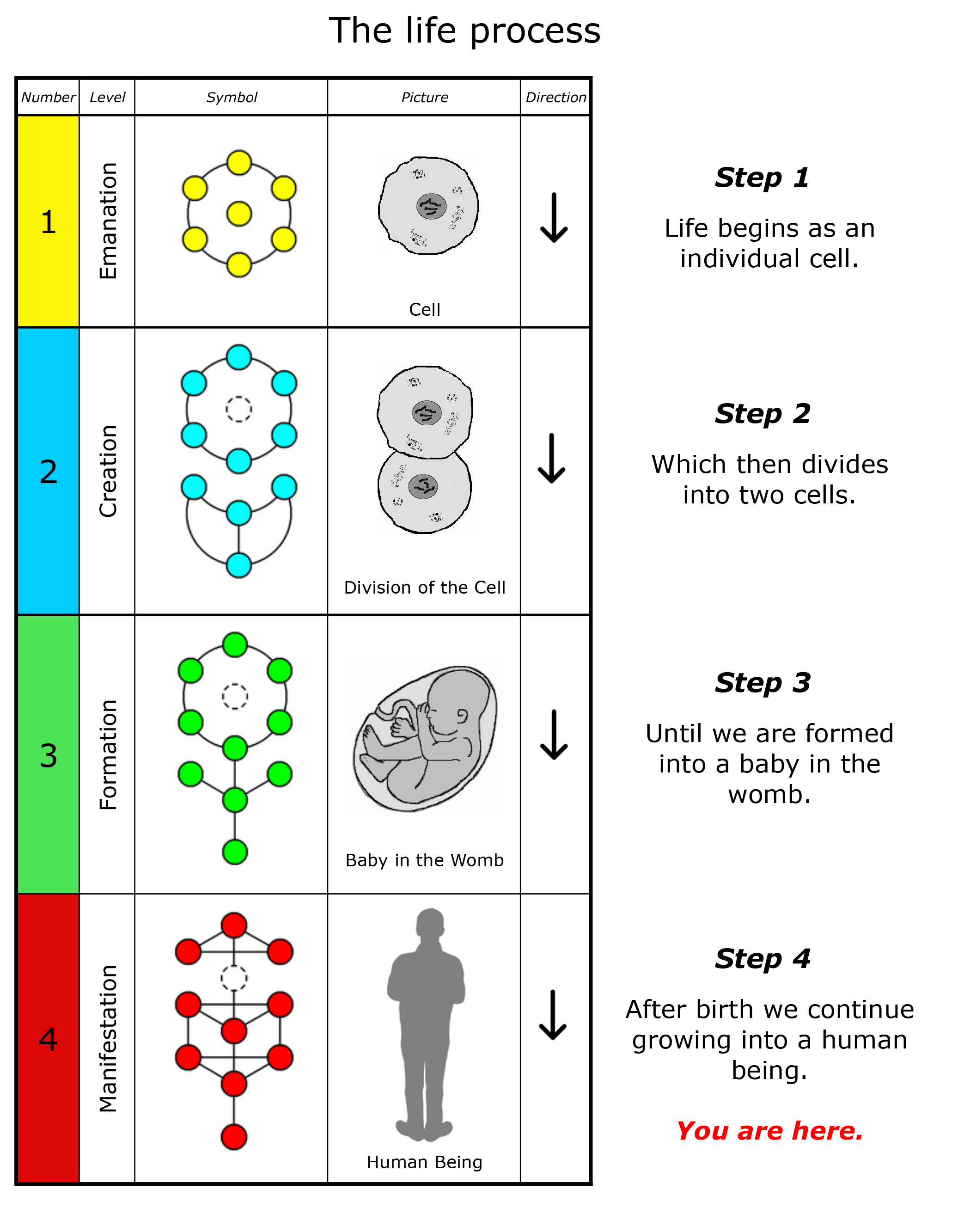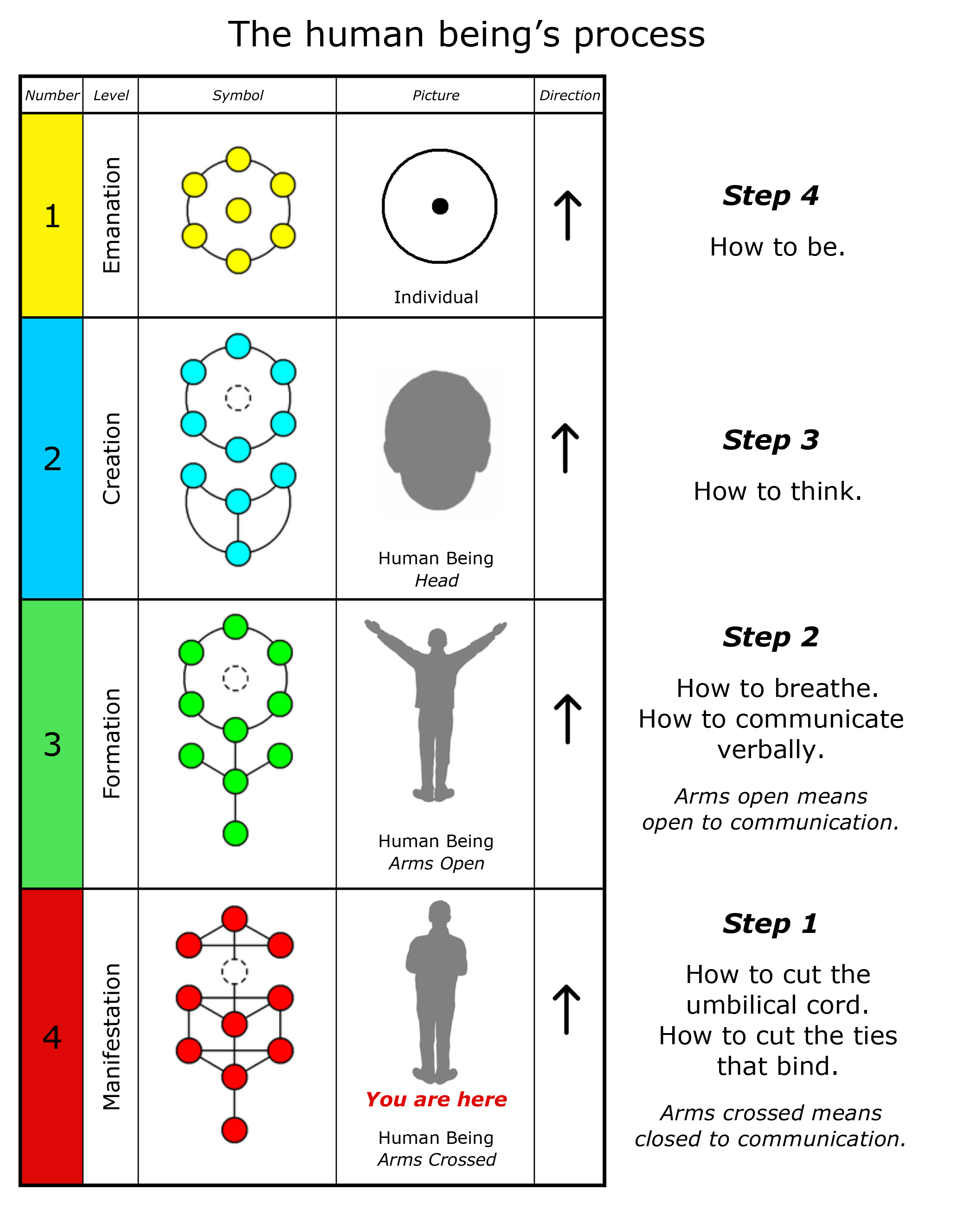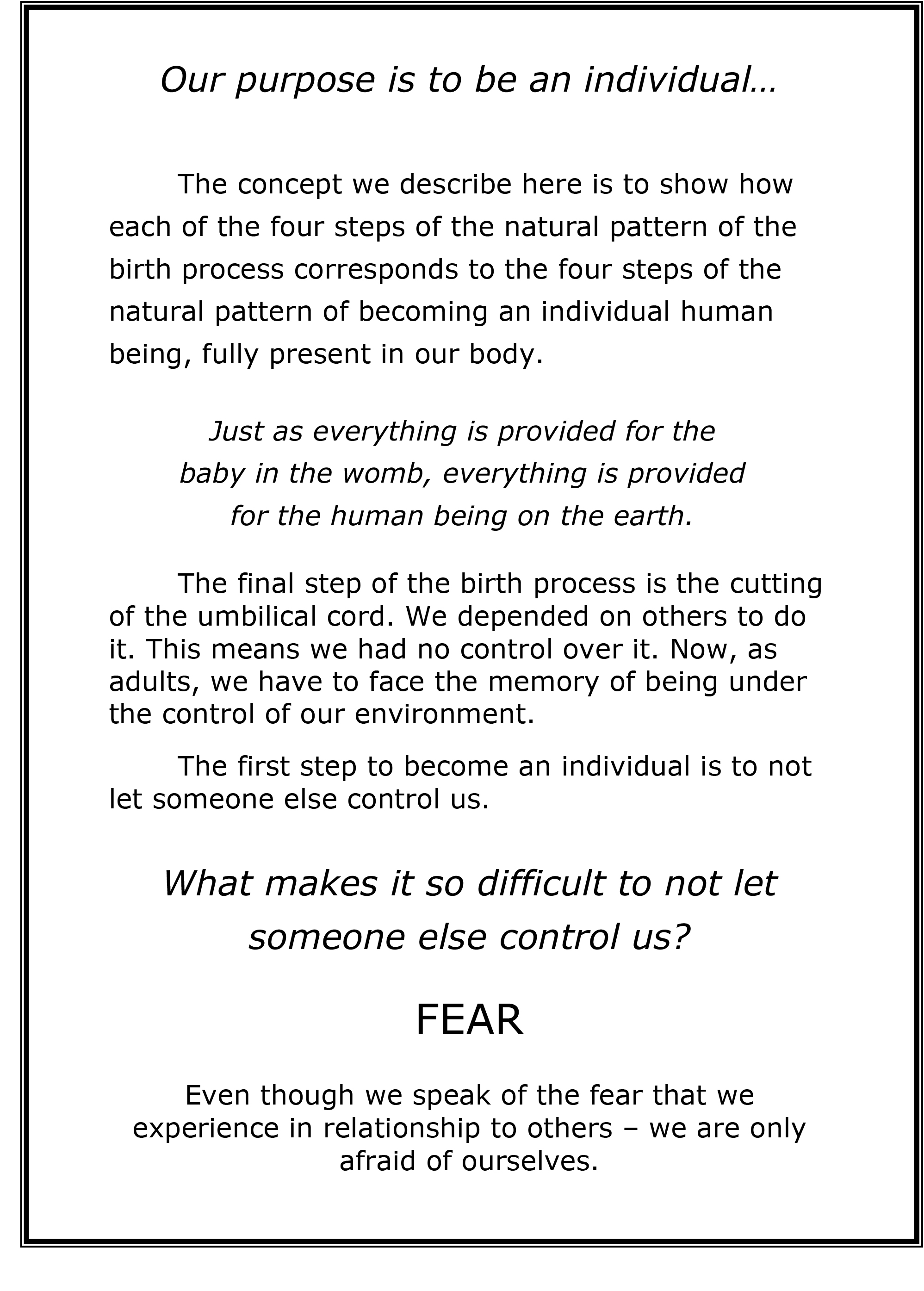
. . . .
Table of Contents
b – What did you go through to get here?
c – Where do you go from here?
a – What is common to every human being on the earth?
b – The birth process and the corresponding “Exterior Tools”
III – What makes the difference between two human beings?
a – How do we know we are afraid?
b – The birth process: a blueprint for showing how the body experiences fear
c – Observing the fear process in slow motion.
d – Let’s look at a situation that makes us afraid.
e – Moving through fear by taking the path of connection.
f – What is the way to move towards fear?
IV – Where do we start and what do we do first?
a – How does the Birth Process correspond to the Human Being’s Process?
. . . .
I – Now where do we go?
We will use pictures to show how the life process corresponds to the birth process and to the human being’s process.
Observe how each of these processes follows the same pattern. There is a natural progression to each of these processes.
We will focus on the pattern of the birth process and how that pattern relates to the human being’s journey to become an individual.
The birth process follows a natural order. We cannot begin to breath on our own before we have left the comfortable environment of the womb.

.
a – How did you get here?
.
b – What did you go through to get here?
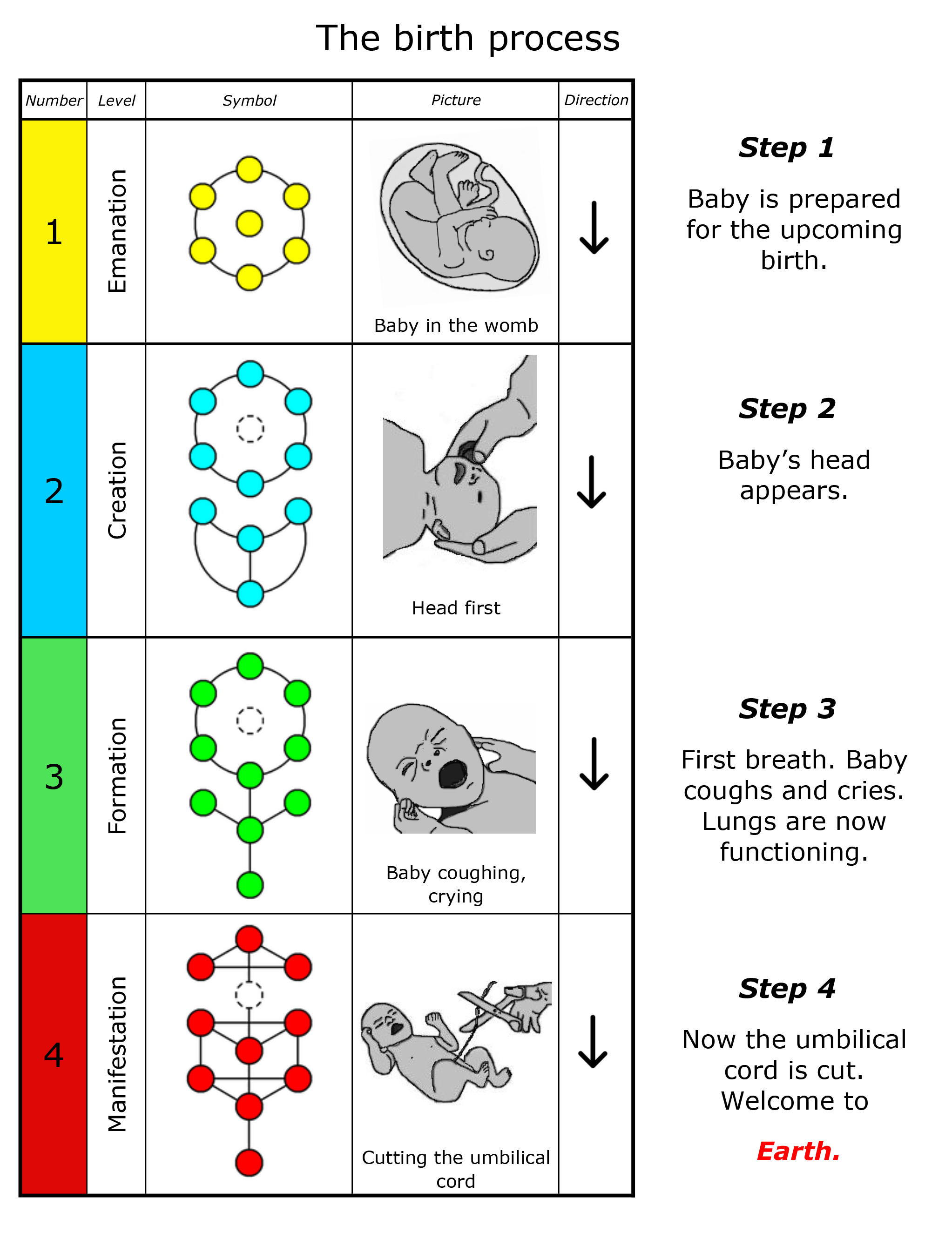
.
c – Where do you go from here?
.
d – Cycle of life
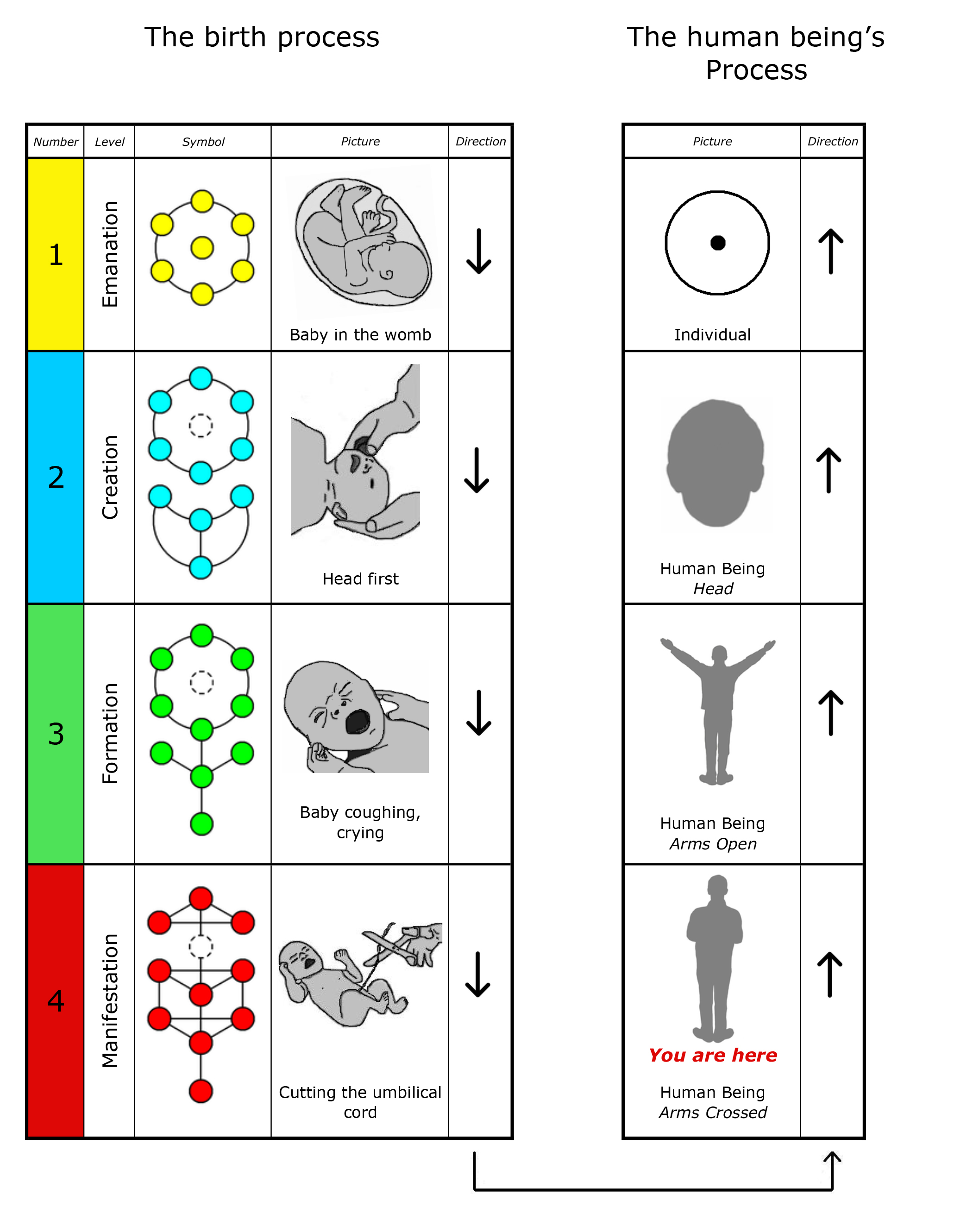
. . . .
II – Becoming a Human Being
The main concept explains in a simplified manner, how the four steps of the birth process are linked to the four steps of the human being becoming an individual.
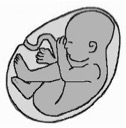 In the first stage of the birth process we show the baby in the womb. This is the time when the baby develops and grows. It is a tremendous transformation. At the same moment, the womb is a peaceful environment where all needs are provided and the baby doesn’t have to worry about anything.
In the first stage of the birth process we show the baby in the womb. This is the time when the baby develops and grows. It is a tremendous transformation. At the same moment, the womb is a peaceful environment where all needs are provided and the baby doesn’t have to worry about anything.
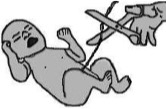 The baby in the womb receives its support and connection to life through the umbilical cord until the birth process is completed. The birth process is complete when the umbilical cord is cut. This is the only step where the baby has no control. The journey to become an individual begins with the cutting of the umbilical cord.
The baby in the womb receives its support and connection to life through the umbilical cord until the birth process is completed. The birth process is complete when the umbilical cord is cut. This is the only step where the baby has no control. The journey to become an individual begins with the cutting of the umbilical cord.
The process of breathing and cutting the umbilical cord are obligatory steps for living on the earth. It is a physical transition, which everyone must pass through.
The umbilical cord is a physical connection but it is not the only connection we have. There is also a non-physical connection. When we are in the womb we are connected both physically and non-physically.
Cutting the umbilical cord is a big transition and we think our entire connection has been cut. The source of connection and sustenance seems to have vanished.
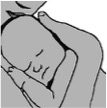 Now the mother takes over the care of the baby in a more active way. She holds the baby lovingly and provides nourishment through breast-feeding. The mother and father provide the support so that one day the baby will be able to live independently.
Now the mother takes over the care of the baby in a more active way. She holds the baby lovingly and provides nourishment through breast-feeding. The mother and father provide the support so that one day the baby will be able to live independently.
We human beings think that once we are born we must control everything in order to live our lives “properly.” But just as the birth process happens naturally the process of becoming an individual also happens naturally.
![]()
.
a – What is common to every human being on the earth?
The Physical Body
Human beings know each other by our specific physical structure—our bodies. No matter how different our physical bodies are we can always distinguish between the human being and other types of life on the earth.
The human being is formed in the womb. This is the place where the “exterior tools” for dealing with life on earth are prepared. To be in accordance with duality on earth the “exterior tools” of the body each have the capability of being passive or active.
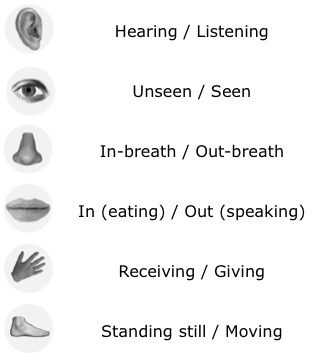
.
b – The birth process and the corresponding “Exterior Tools”
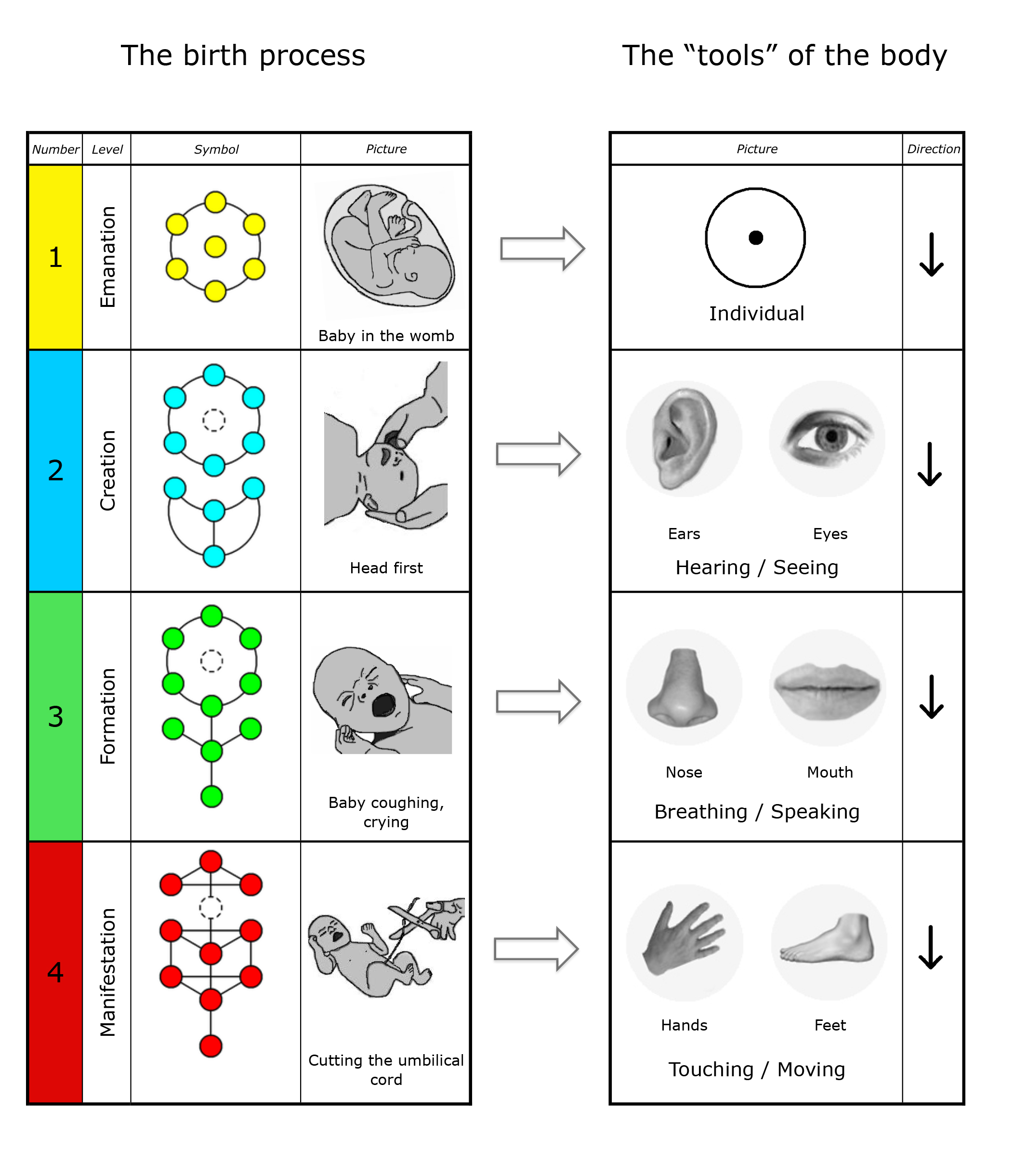
1 – Hearing and Seeing

In the womb the baby’s ears are functioning while the eyes are closed. The baby hears what’s going on outside. At birth the ears continue to function and the eyes open.
It looks like our ability to hear has been turned on from the time we were in the womb to now. Sometimes we hear a noise but can’t identify it until we see it.
Our dominant “tool” on the earth is the eyes. The eyes create two ways of seeing reality—the seen and the unseen.

If we look at the earth from space we can see half of the earth and the other half is hidden. Everything has a visible and an invisible side.
In the womb the baby’s eyes are closed and will open at birth. When our eyes are closed we are in an interior mode and when our eyes are open we are in an exterior mode.
Now that we are living on the earth we have naturally forgotten about the importance of our time in the womb. We focus ourselves only with what we can see on the earth.
What we see is what we know.
What is unseen is unknown to us.
Most of the time we act based on what we know in any given situation. The seen is the familiar path; the unseen is the unfamiliar path.

.
2 – Breathing and Speaking
 Separation plays a big part in our life. At birth, we experienced the first separation as we passed from the womb to the earth. The baby came from a water environment (womb) to an air environment (earth). This means the baby has to breathe in order to live on the earth.
Separation plays a big part in our life. At birth, we experienced the first separation as we passed from the womb to the earth. The baby came from a water environment (womb) to an air environment (earth). This means the baby has to breathe in order to live on the earth.
If breathing is the first important function, each time we experience separation we must reconnect to our breath. Breathing is life.
How are breathing and speaking related?
The nose is the organ for breathing and the mouth is the organ for speaking. Both breathing and speaking share the same element – Air.
When an emotion arises, we are brought back to the memory of the passage from the womb (water) to the earth (air). Our breathing becomes shallow and rapid and sometimes we even stop breathing for a moment. Just as the baby coughs and cries at birth, if we speak when we are emotional, we may end up coughing and crying instead of communicating our point.
Can you breathe or speak when your head is under water?
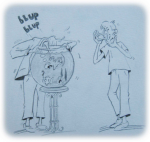
.
3 – Touching and Moving
 When the umbilical cord is cut, we are liberated from being physically attached to the womb. We are on our own. With no “cord” to attach us, we can move without restraint.
When the umbilical cord is cut, we are liberated from being physically attached to the womb. We are on our own. With no “cord” to attach us, we can move without restraint.
The baby in the womb was in a confined environment. At birth, the baby enters into a wide-open space. Even though we are free to move in the new space we must learn new skills to do so. The baby develops the ability to grasp and manipulate object with the hands and learns to walk with the feet.
Our feet are the vehicle our body uses to move us from one place to another. They are the mode of action for the body. We use our feet to explore our surroundings.
Our sense of touch is most directly related to our hands. They have multiple functions such as making contact, exploring boundaries and as a mechanism for creating and manipulating the environment.
The feet are connected to the earth while the hands are connected to the environment. Our hands can be open or closed and our feet can either move towards something or away from it. The actions of the feet and the hands are connected to each other.
. . . .
III – What makes the difference between two human beings?
THE MIND
If two human beings are so similar in their physical structure what makes one act one way and another act differently in the same situation? The mind.
The physical body and the mind can be compared to a car and a driver where the body is the car and the mind is the driver. For the car and driver to operate efficiently they must act as a unit. If the driver is not conscious, there can be a meeting…
What causes separation between the body and the mind?
FEAR
Is separation linked with fear?
At birth, we experienced the first separation as we passed from the womb to the earth. Then a second separation occurred – the cutting of the umbilical cord.
We came from a nourishing environment and were propelled into an unknown territory.

.
a – How do we know we are afraid?
OUR PHYSICAL BODY TELLS US.
When the umbilical cord was cut we passed from the interior world of the womb to experience a new type of reality—the exterior world. Now we are using our physical senses to perceive reality on the earth.
When the separation occurred we were divided between the passivity of the womb and the activity on the earth. Now our focus is externally driven by our physical senses and that causes us to forget about our internal experience in the womb.
Our physical body is like an antenna. Each part of our body has a function to decipher whether or not the environment is safe. All of the “exterior tools” of the body work together as a unit.
The body will use the appropriate “tool” for a given situation. For example, when the eyes are not able to see then the body can still receive information through the ears or the hands.
What are the physical signs of fear?
Hearing/Seeing – Breathing/Speaking – Touching/Moving
If we are afraid our eyes are the first to tell us. Then our breathing changes and we either have a fight or flight response or we become paralyzed.
When our breathing changes, so does our ability to deal with the situation we are facing. By regaining our breath we can embrace the situation and move through our fear.
.
b – The birth process: a blueprint for showing how the body experiences fear
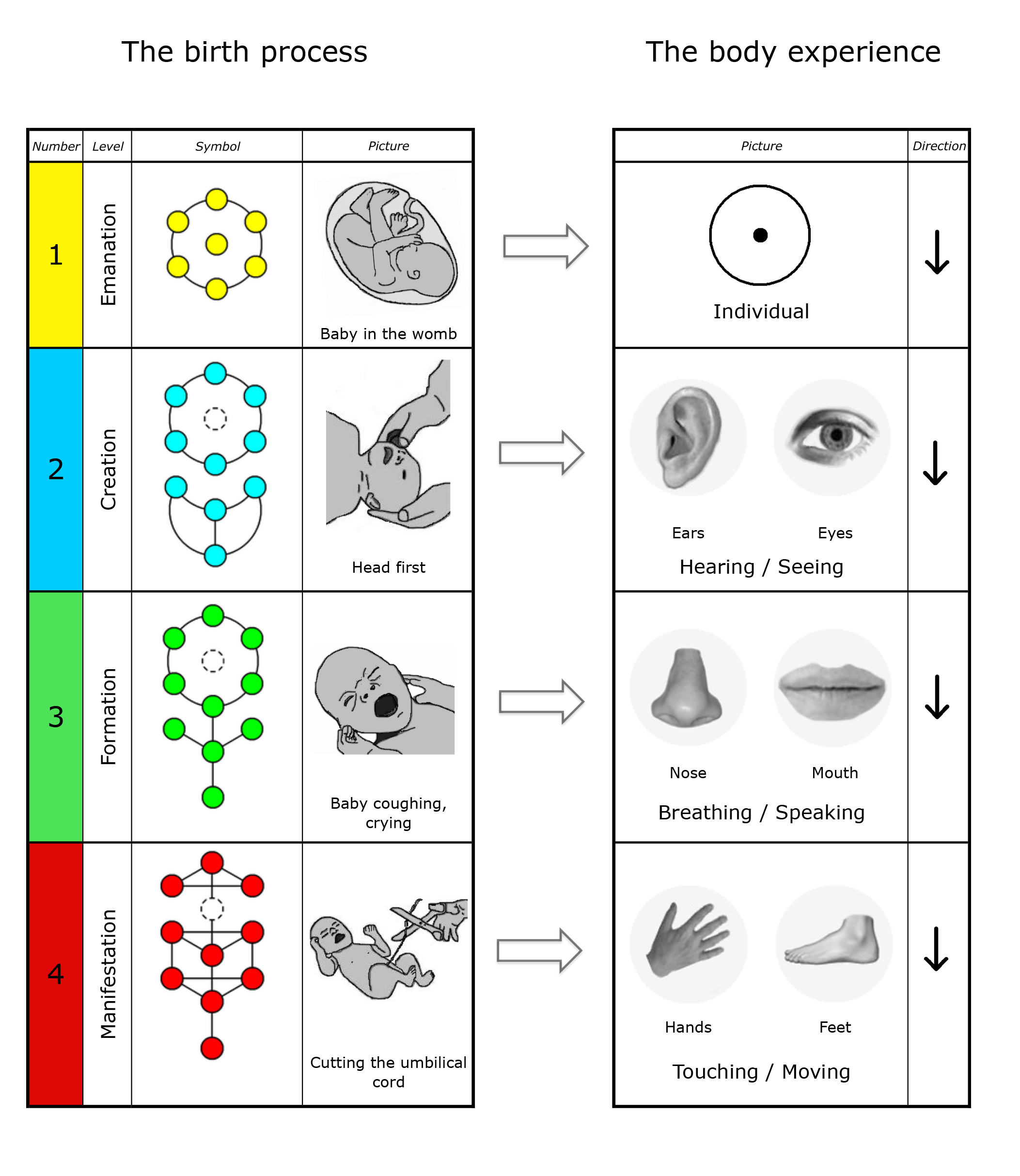
Birth is a natural process that we have no control over. Our experience of birth was so quick that we had no time to understand what was happening. It’s like a movie where the frame rate is too fast for us to perceive individual pictures —we only see the overall movement. In order to understand the significance of the birth process we slow down the frame rate so the individual steps become visible.
During the birth process we were expelled from the safe environment of the womb to a completely new environment. We experienced that expulsion as a separation. That experience was imprinted on us and we still associate separation with fear.
It looks like we have to face the individual steps again. By understanding the process we can take action to liberate ourselves from the primordial fear of separation. In this way we will be more conscious about our own fear and be able to make different choices when a situation arises. The energy we were using to protect us from the external environment will be transformed to an interior energy. This is when the healing will take place.

Interestingly, we experience fear too quickly to understand what is happening. As we begin to slow down our experience of fear we can feel how it moves through our body in a similar pattern to the birth process. Each step of the birth process has its own expression of fear.
.
c – Observing the fear process in slow motion.
![]() 1 – This is the stage when we are involved with normal daily activities. Whatever we are doing is fine. We are not in a crisis mode. We are like the baby in the womb.
1 – This is the stage when we are involved with normal daily activities. Whatever we are doing is fine. We are not in a crisis mode. We are like the baby in the womb.
 2 – This is the stage where fear is created. Just as when the baby’s head appears and begins to experience the environment through hearing and seeing, we become afraid if we see or hear something. This is the first step in the process of fear. We have to see, hear or imagine something in order to be afraid.
2 – This is the stage where fear is created. Just as when the baby’s head appears and begins to experience the environment through hearing and seeing, we become afraid if we see or hear something. This is the first step in the process of fear. We have to see, hear or imagine something in order to be afraid.
 3 – This is the stage where fear takes form. Just as the baby struggles to take the first breath, we struggle to breath when we are feeling fear. Our breathing may become shallow, blocked or we may start yelling or be speechless.
3 – This is the stage where fear takes form. Just as the baby struggles to take the first breath, we struggle to breath when we are feeling fear. Our breathing may become shallow, blocked or we may start yelling or be speechless.
 4 – This is the stage where fear becomes real. Just as the baby is not in control of cutting the umbilical cord — which must be cut by somebody else — we are not in control of ourselves until we take action in regards to our own fear.
4 – This is the stage where fear becomes real. Just as the baby is not in control of cutting the umbilical cord — which must be cut by somebody else — we are not in control of ourselves until we take action in regards to our own fear.
Now we have the choice to take the scissors into our own hands and cut our ties to fear.
In order to take the scissors into our own hands we have to begin where we left off: the final step of the birth process (the cutting of the umbilical cord).
 We depended on others to cut the umbilical cord. This means that we had no control over the situation. Now we have to face the memory of being under the control of our environment.
We depended on others to cut the umbilical cord. This means that we had no control over the situation. Now we have to face the memory of being under the control of our environment.
As adults, we try to create a “safe environment” (just like the womb) through our house, job, relationship, etc. But no matter what we do, an exterior factor, losing job, house, relationship, etc., propels us to a new environment.
We try to hold on to what we know and push away what we don’t know. This moves us nowhere and requires a lot of energy. If we try to maintain our attachment to the old environment we will find ourselves paddling upstream. At a certain point we will be too tired to continue fighting the current. We will have to let go and accept the flow of life.
To move forward we have to look at both sides: the old and the new environment.
![]() By opening ourselves to the possibility of “losing” we began to take the situation in our own hands. Looking at both side of the situation we keep the scale in balance. We have to have the same weight on both sides of the scale. To do this we must have trust and have no expectation about how it will turn out.
By opening ourselves to the possibility of “losing” we began to take the situation in our own hands. Looking at both side of the situation we keep the scale in balance. We have to have the same weight on both sides of the scale. To do this we must have trust and have no expectation about how it will turn out.
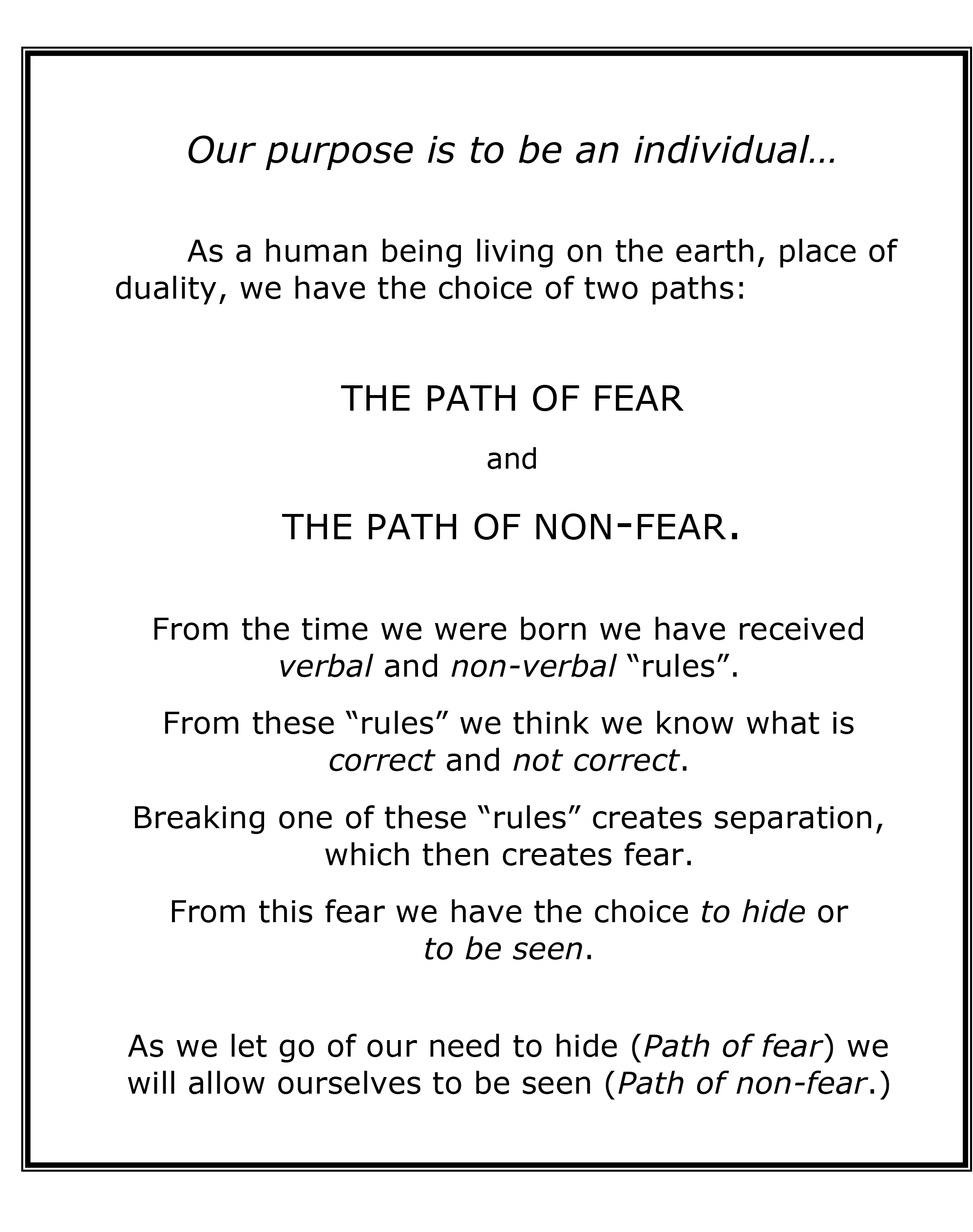
d – Let’s look at a situation that makes us afraid.
We take as an example the fear of losing our house.
![]() 1 – This is the step where we are safe in our house.
1 – This is the step where we are safe in our house.
 2 – This is the step where we begin to be afraid. We hear that we might lose our job or we see that we are having trouble of paying our bills. Subconsciously this brings us back to the moment our head first emerged during the birth process.
2 – This is the step where we begin to be afraid. We hear that we might lose our job or we see that we are having trouble of paying our bills. Subconsciously this brings us back to the moment our head first emerged during the birth process.
 3 – This is the step where we speak about our fear of losing our house. We may blame others or make excuses for ourselves. Subconsciously this brings us back to the moment we were coughing and crying during our first breaths.
3 – This is the step where we speak about our fear of losing our house. We may blame others or make excuses for ourselves. Subconsciously this brings us back to the moment we were coughing and crying during our first breaths.
 4 – This is the step where we do everything to try to keep our house. We are looking at only one side – keeping the house. We are at the mercy of the bank or our employer who can cut our ties to the house. Subconsciously this brings us back to the moment when an exterior person cut the umbilical cord.
4 – This is the step where we do everything to try to keep our house. We are looking at only one side – keeping the house. We are at the mercy of the bank or our employer who can cut our ties to the house. Subconsciously this brings us back to the moment when an exterior person cut the umbilical cord.
.
e – What is the way to move towards fear?
We described above how to recognize our fear. Most of the time we are taught to push our fear away. In avoiding our fear we try to protect ourselves and we project it onto others. We are not taking responsibility for our actions. This book teaches us that in order to deal with our fear we need to face it so it doesn’t control us.
In order to be true to ourselves we must cut the cords that control us.

It is very interesting to see that the last step in the birth process is to cut the umbilical cord and the first step to be your own person is also to cut the cord of fear—which we describe as cutting the ties that bind.
Each time we deal with a fear it’s like an initiation, a passage. These initiations are a natural process. We have to go through it otherwise it will come back later.
When we observe the life of a tree, we see the tree growing towards the sun. What we don’t see is the roots. Without an adequate system of roots the tree cannot stand. As the tree grows the roots do too. The roots are the foundation of the tree.
We are not different from the tree. Our foundation is like the roots of the tree. We grow our foundation each time we move through our fear in a loving way.
.
f – Moving through fear by taking the path of connection.
 1 – When we protect ourselves and let the situation control our reactions, we are out of balance because we put all of our energy into one side of the scale. All we can think about is that we want to keep our house.
1 – When we protect ourselves and let the situation control our reactions, we are out of balance because we put all of our energy into one side of the scale. All we can think about is that we want to keep our house.
We start to be in balance and begin moving forward when we face the possibility of losing our house. It is important to know that moving forward doesn’t mean that we stop being afraid. It simply means that we can open ourselves to two different outcomes.
 2 – This is the step where we embrace our fear. We speak about our true fear by taking responsibility.
2 – This is the step where we embrace our fear. We speak about our true fear by taking responsibility.
 3 – This is the step where we understand our fear, where it came from and how it was controlling us.
3 – This is the step where we understand our fear, where it came from and how it was controlling us.
 4 – This is the step where we trust the process.
4 – This is the step where we trust the process.
We have passed through the door.
.
g – The door of Fire
What do we expect when we pass through the door?
When we are afraid we are actually near the door of fire. We can either go through the door by experiencing our fear or stay where we are by protecting ourselves.
Until we pass all the way through the door we are in transition. This transition can be short or long. If we try to control it, the transition will be longer or we can even stop the process.
In the course of going through the door our fear is trying to pull us back— to stop us. We are in a place that is unknown to us. We can feel our energy spinning throughout our body. Sometimes we have clarity; sometimes we are confused. We have ups and downs. We try to hold to what we know. Just stay the course, the energy will calm down. We will feel different.
Once we are through the door we enter into an integration phase. We will feel very light and have a sense of clarity. It’s a euphoric feeling. The veil has been removed and the gift has been received.
Just because we have passed through the door does not mean we are done. We have only reached a new level. We are not the same as we were before. The knowledge we have gained can help us to deal with our life. Our foundation is now stronger.
Did you notice how passing through the door is similar to the birth process?
To illustrate this process let’s take a look at nature.
.
The transformation of the caterpillar into the butterfly

When the caterpillar is ready it turns into a chrysalis. The inner transformation of the chrysalis allows the butterfly to emerge.
We are the caterpillar when we feel our fear. When we take responsibility for our action, we enter into the chrysalis.
The chrysalis is the time of transition. This is the time when we will feel in the “dark”. We feel we have lost our bearings.
We will emerge from our chrysalis only after the inner transformation is complete. This is an individual process.
Just as we cannot help the butterfly to come early by opening the chrysalis we have to do our inner work ourself. Trying to be rescued is not taking responsibility for our actions and it will only kill the process.
![]()
. . . .
IV – Where do we start and what do we do first?
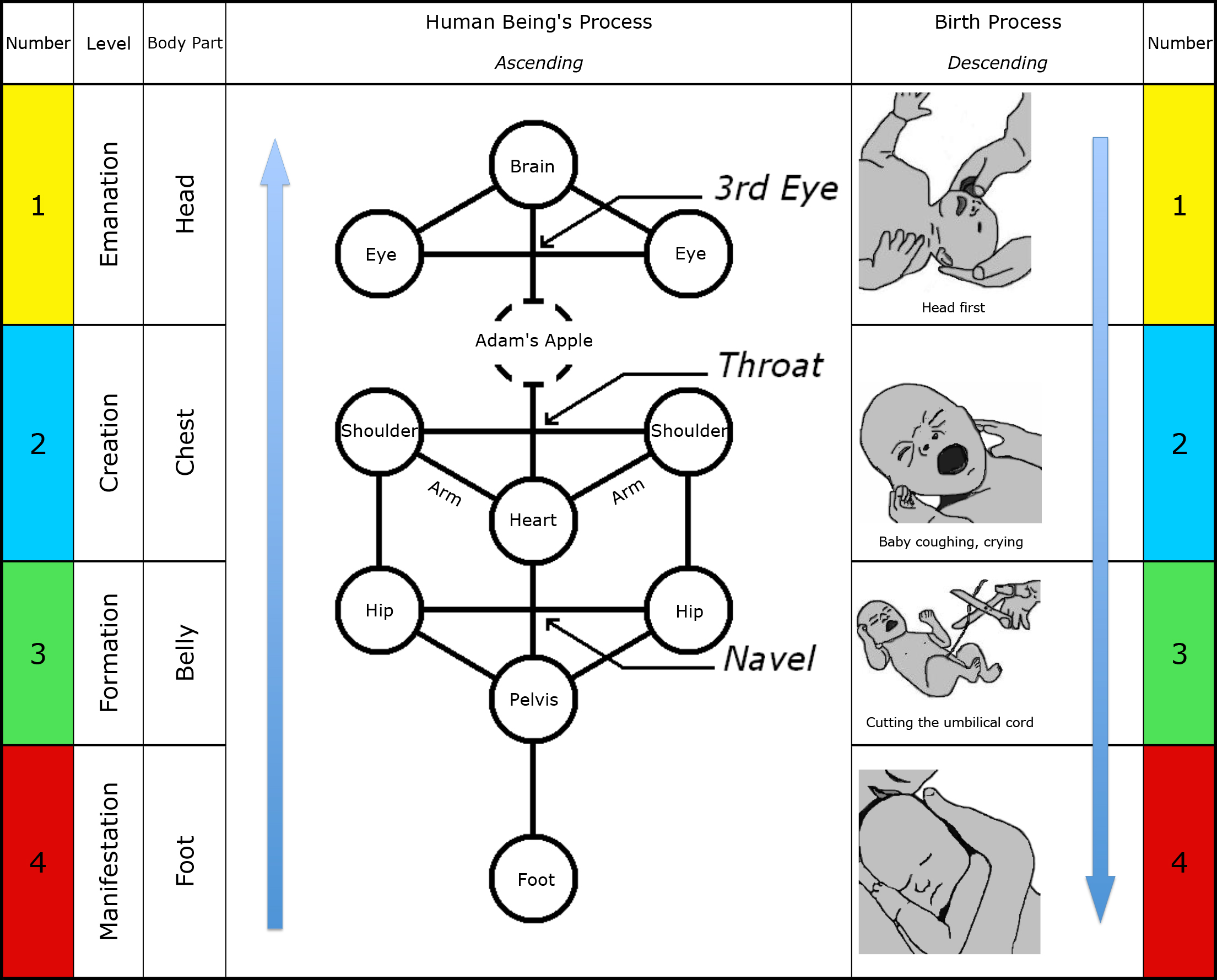
Let’s return back to the birth process because it shows us where we left off and what we need to do first.
Remember, the birth process is natural and unfolds in a consistent step-by-step pattern.
THE BIRTH PROCESS
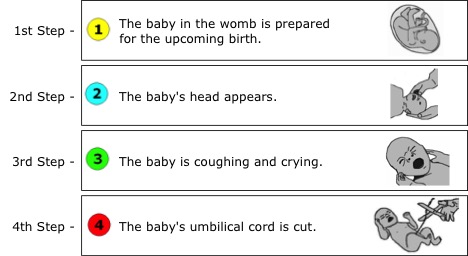
The cutting of the umbilical cord is the final step of the birth process in becoming a human being on the Earth.
The human being’s process is to manage fear. We manage our fear by following the steps of the birth process in reverse.
Let’s look at what these steps are like for a human being.
When we are afraid we must begin where we are. This is what we mean when we say ” You are here.” Once we know where we are, we can start to cut the ties that bind us to fear.
In the human being’s process, the First Step (4) corresponds to the last step in the birth process. Both of these steps deal with cutting: the ties that bind and the umbilical cord.
THE HUMAN BEING’S PROCESS
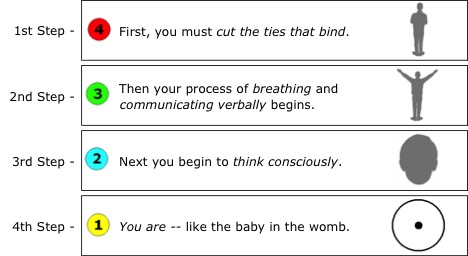
Remember, the order of the human being’s process is the reverse of the birth process. If we argue or make excuses we are out of order. Our words will be wrapped up with our fear and we will sound as if we are coughing and crying like a baby.
.
a – How does the Birth Process correspond to the Human Being’s Process?
Step 1: Cutting the umbilical cord is similar to cutting the ties that bind when we have crossed arms.
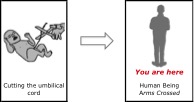
Let’s see how the two are similar…
In these pictures both the baby and the human being are ready to cut ties.
- The umbilical cord will be cut for the baby.
- The human being needs to cut the ties to fear before becoming an individual.
Why do we show the human being with crossed arms?
Crossing our arms is one way to protect ourselves. This is a physical sign showing that we are afraid. In doing this we cannot reach out or touch another person.
Crossing our arms creates an energetic separation between the lower and the upper body at the level of the heart. The lower body contains the emotions and the upper body contains the ability to communicate. Crossing our arms cuts the ability to communicate our emotions in a loving way.
![]()
.
What happens when we cross our arms?
When we cross our arms we force our emotions to stay down. When an emotion is suppressed, it is expressed as fear.
Are we protecting ourselves from our deepest emotions?
The block we create by crossing our arms constricts our heart. This is the energetic umbilical cord—the cord of fear we need to cut. This is the tie that binds.
Crossing our arms separates our body into two parts.

.
The upper part of our body
————————-
The lower part of our body
.
The upper part of our body deals with verbal communications.
The lower part of our body deals with emotions.

Verbal communications
————————
Seat of the emotions
.

.
Step 2: Baby coughing and crying is similar to breathing and communicating verbally when we have open arms.
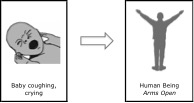
Let’s see how the two are similar…
In these pictures both the baby and the human being are ready to breathe.
- The baby’s coughing and crying opens the lungs.
- The human being’s open arms create a flow between the lower and upper part of the body through breathing.
Why do we show the human being with open arms?
We open our arms when we have no need to protect ourselves. This is a physical sign showing that we are ready to embrace. In doing this we create an energetic flow.
Opening our arms creates an energetic flow between the lower and the upper body. We are able to use our breath to maintain the openness of our heart. This enables us to communicate our emotions in a loving way.
What happens when we open our arms?
When we open our arms we are in contact with our emotions. When our emotions are not suppressed, we communicate in a loving way.
We are ready to speak from our heart!
The flow we create by opening our arms expands our heart. By putting our consciousness into our breathing we maintain the flow and our heart remains open.
Opening our arms unifies our body. Breathing in and out is the link between the upper and lower body.
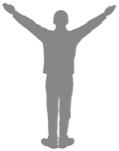
Breathing IN and OUT
.
Every time we feel love we are making ourselves bigger.
Every time we feel fear we are making ourselves smaller.
.

. . . .

